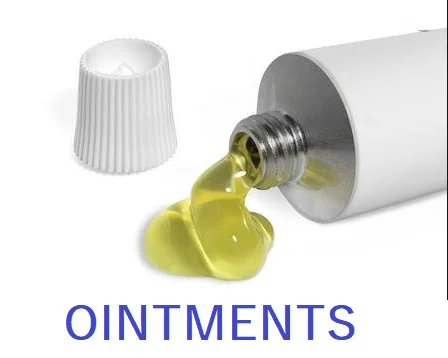BURN CURE CREAM (Acriflavine & Thymol Cream)
A topical antiseptic is indicated in the treatment of infected wounds and for skin disinfection.
BURN CURE CREAM is an antiseptic (applied to living tissue/skin to reduce the possibility of infection) and bacteriostat (prevent or inhibit bacterial growth). Acriflavine is slow-acting with bacteriostatic action against many gram-positive organisms and increased activity in alkaline solutions. Thymol has strong antiseptic properties. Mechanism of action: acriflavine is a mixture of proflavine and euflavine.
Acridine dyes are bactericidal because of their interaction with bacterial nucleic acids. Only euflavine has effective antimicrobial properties. They are more effective against gram-positive bacteria than gram-negative bacteria and are more bacteriostatic in action. It relieves pain, prevents infection, and promotes healing. Indications: Indications for minor cuts, burns, wounds, pus, bruises, and topical skin infections. Contraindications: hypersensitivity to any of the ingredients of this medicine. Not indicated for the treatment of fungal infections. Side effects: sensitivity reactions with the skin. Dosage: as advised by the physician. Storage: store at a temperature below 25c. Do not freeze.
PURPOSE: This Master Formula is written to describe the formulae, manufacturing procedure, specifications, packing details of dosage form.
SCOPE: This MFR is performed and is applied during the manufacturing of dosage form.
RESPONSIBILITY / ACCOUNTABILITY: It is the responsibility of Assistant Manufacturing Chemist to follow and adhere to this SOP. The Production, QC/QA Manager are accountable for the strict adherence to the master formula.
COPY ISSUED TO:
1. Master Copy: Manager Quality Assurance
2. Copy No. 1: Production Pharmacist
3. Copy No. 2: Manager Quality Control
4. Copy No. 3: Ointment Section
| PRODUCT NAME: BURN CURE CREAM | BATCH SIZE: 500 Kg |
| PRODUCT REFERENCE CODE: | UNIT SIZE: 20 g |
| GENERIC NAME: N.A. | PACK SIZE: 18 ´ 20 ´ 10 g |
| DOSAGE FORM: OINTMENT | STRENGTH: N.A. |
| DEPARTMENT: OINTMENT DEPARTMENT | EXPIRY DATE: AFTER 36 MONTHS FROM THE DATE OF MANUFACTURING |
COMPOSITION:
For 100g:
| Acriflavine | B. P.C.63 | 0.12g |
| Thymol | B. P. | 5mg |
SPECIMEN UNIT CARTON:
EQUIPMENTS TO BE USED:
| SR. NO. | NAME OF EQUIPMENT | ASSEMBLING AS PER SOP NO. | CLEANING AS PER SOP NO. |
| 1 | Wax Vessel | ||
| 2 | Water Vessel | ||
| 3 | Mixing Vessel | ||
| 4 | Storage Container-I (500 Kg) | ||
| 5 | Semiautomatic Aluminium Tube Filling & Crimping Machine |
RAW MATERIALS:
| S.NO. | INGREDIENTS | STD | Theoretical Quantity Req. | Overages % | Total Quantity Used |
| 1 | ACRIFLAVINE | B.P.C.63 | 600.000 | 10.00 | 660.000 GM |
| 2 | CM – 1000 | B.P. | 16.666 | 16.666 KG | |
| 3 | CETOCETYL ALCOHOL | B.P. | 50.000 | 50.000 KG | |
| 4 | EDTA | B.P. | 0.500 | 0.500 KG | |
| 5 | LIQUID PARAFFIN LIGHT | B.P. | 25.000 | 25.00 KG | |
| 6 | SODIUM BENZOATE | B.P. | 2.500 | 2.500 KG | |
| 7 | S.M.B.S | B.P. | 0.500 | 0.500 KG | |
| 8 | SPIRIT CHLOROFORM | I.P. | 1.000 | 1.000 BTLS | |
| 9 | THYMOL | B.P. | 0.020 | 60.00 | 0.032 KG |
| 10 | WHITE PETROLEUM JELLY | U.S.P. | 80.000 | 80.000 KG |
PACKING MATERIALS: –
| S.NO. | NAME OF THE MATERIAL | THEORETICAL QUANTITY REQ. | FOR RECORD | TOTAL QUANTITY USED |
| 1 | ADHESIVE TAPE ROLL BROWN | 2.000 | 2.000 NOS | |
| 2 | UNIT CARTON | 25000.000 | 3.000 | 25003.000 NOS |
| 3 | OUTER CARTON | 1250.00 | 2.000 | 1252.00 NOS |
| 4 | TUBES | 25000.000 | 25000.000 NOS | |
| 5 | CELLO TAPE | 3.000 | 3.000 NOS | |
| 6 | CORRUGATED BOXES S – 36 | 69000.000 | 69000.000 NOS |
MANUFACTURING SPECIFICATIONS:
1. Average fill of each Tube is 20 grams.
2.Wight variation limit allowed in each filled Tube is + 200 mgs.
3.Melt the ointment base at the maintained temperature of 70˚ C.
4.Use accurate weight quantity of water to make up the final weight of cream.
5.The temperature of primary area should not be more than 30˚C.
Yield:
·Theoretical Yield is 25000 Tubes.
·Expected Practical Yield is 25000 + 2% Tube.
Packing Details:
1. Transfer the cream from storage tank to Semiautomatic Aluminium Tube Filling & Crimping Machine and start filling and then Crimping of the tubes as per its SOP.
2.Pack the filled tubes in unit carton.
3.Pack such 20 tubes in each outer carton.
4.Seal the outer carton with cello tape.
5.Pack the 18 outer cartons in specified corrugated S-36 box to give a pack size of 18 x 20 x 20 g Tubes.
6.Seal the each corrugated box with adhesive tape and label it properly by affixing the specified label.
MANUFACTURING PROCESS:
1. Melt 16.666 kgs of Ceto Macrogol- 1000, 50 kgs of Cetocetyl Alcohol, 25.0 kgs of Liquid Paraffin Light and 80.0 kgs White Petroleum Jelly in a Steam Heat Wax Melting Vessel by operating it as per its SOP at temperature 70° C.
2.Heat 324.50 kg of water at 70° C in Water Vessel by operating it as per its SOP.
3.Filter and transfer the melted base through Stainless Steel Sieve no. 100 to the mixing vessel and start the machine as per its SOP.
4.Dissolve 0.500 kg of EDTA in 4 kg of water and transfer it to the bulk batch.
5.Dissolve 0.500 kg of Sodium Metabisulphite in 4 kg of water and transfer it to the bulk batch.
6.Dissolve 2.500 kg of Sodium Benzoate in 10 kg of water and transfer it to the bulk batch.
7.Slowly add rest of water to the bulk batch.
8.Cool the cream to the room temperature by running the water in the jacket of mixing vessel.
9.Triturate 660.00 kg of Acriflavine in 7.0kgs of Liquid Paraffin Light in mortar–pestle and add to the bulk batch.
10.Dissolve 0.032 kg of thymol in 450 ml of Spirit Chloroform.
11.Mix the whole batch for 90 minutes while running the water in the jacket.
12.Send the sample to Quality Control Department for bulk testing.
13.After approval from Quality Control Department, transfer the cream to storage tank.
IN-PROCESS CONTROLS:
The following in-process controls should be maintained during the processing:
1. Check Raw materials used for manufacturing purpose are all approved materials and have ‘Released’ labels fixed on it.
2. All weighed Raw materials should be counter-checked by Assistant Manufacturing Chemist. If any discrepancy is noticed, it should be immediately brought to the notice of Production Pharmacist and QC/QA Manager.
3.Physical characteristics of Raw material like colour, odour, and consistency are checked before compounding.
4.The total weight of bulk ointment / cream should be checked in the presence of Assistant Manufacturing Chemist and record the same in Batch Manufacturing Record.
5.pH of the bulk should be checked and it should be with in specified limits.
6.Bulk sample should be sent for analysis to Quality Control Department before starting the filling and sealing stage.
7.While the tube filling operation is on, the Assistant Manufacturing Chemist should check weight of net filled quantity per tube at the interval of 30 minutes by checking the tare weight of empty tube and gross weight of the filled tube. Record for the same should be kept in Batch Manufacturing Record.
8.The ‘fill weight’ of ointment or cream per tube should not be less than the labelled amount. Limit for Weight Variation: Weight claimed on the carton + 200 mg
9.Manufacturing Chemist will also ensure that the crimping of the filled Aluminium tubes, sealing of plastic tubes is appropriate and embossing of batch number and manufacturing date is conspicuous. Also the quality of embossing will be controlled by adjusting pressure exerted by the jaws, so that pinholes are not developed on the embossed letters / numbers.
10.The inner and outer cartons should be checked thoroughly for proper batch coding.
11. Manufacturing Chemist and Production Pharmacist should randomly check that the correct no. of inner cartons are being packed in each outer cartons and also the correct number of outer cartons in each shipper is exactly the same as that shown in proof.
12.Intimation should be sent to Quality Control Department for finished product sampling and testing.
13. After the completion of filling and packaging, the coded cartons should be accounted for and rejected printed material should be destroyed in the presence of QC/QA Manager. Maintain the destruction of the same in the Batch Manufacturing Record.
14.It will be ensure that filling or packaging equipment has been properly cleaned.
15.Filling or packaging of next product should be commenced only after getting the ‘Line Clearance’ of the previous product, from the Quality Control Analyst.
OTHER RELATED POST – MASTER FORMULA OF DERMIFRESH POWDER (ICE EFFECT)


